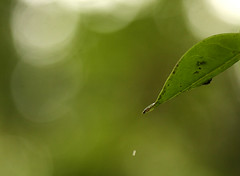 Via Emily Gertz’s tweet of a recent blog post of hers, I was led to Bright Idea Shade on mandiberg.com.
Via Emily Gertz’s tweet of a recent blog post of hers, I was led to Bright Idea Shade on mandiberg.com.
From Eyebeam OpenLab comes and open source idea for making a cover for those glare-y compact fluorescent lightbulbs (CFLs) we are all installing to save energy. But the bare bulbs are, well, unbearable. I’ll embed the video below, because it is wonderful, but I want to add some additional observations about process and values here. The light bulb information is practical and usable, but what is going on with EyeBeam OpenLabs work is what I’m focused on.
What is going on here?
- A problem or need is identified
- A solution is created (in this case, building upon a previous product)
- The idea is opened up an shared and…
- an invitation is made to offer that idea to a manufacturer to reproduce it! (Eyebeam apparently also plans to produce a DIY kit but that is not yet on their site.)
The question that then surface include:
- What is in this for Eyebeam? (Beyond possible sales of a DIY kit which any other manufacturer could also create) What values are being expressed – beyond valuing open source. That part is already clear. Eyebeam’s “about” page gives a 404 error, so it is hard to fully discern by just looking at their web site. It looks like a non profit organization. So I’ll make some guesses that this organization is about the application of design in support of some greater good. Thus they find willing funders to fund their work and they “give away” their ideas as the result of that work. The additional benefit is the support of the designers and artists in doing their work and advancing their own practice. Hopefully the open source values continue past their participation in Eyebeam work. As a result, Eyebeam builds a good reputation and attracts more funding. So doing good does good for the existence of the organization. Does this apply only to non profits? As a small business person, I’d say no, it applies more widely. But is it practiced? Have businesses seen the strategic value of a triple bottom line that includes public good?
- What motivates people to solve problems and give away the answers? Is there a certain set of characteristics that motivate people to do this? My personal guess is yes – thinks like a perspective of abundance (as in good ideas) rather than scarcity, belief in the existence of many possibilities, and some sense of optimism. But I think it is bigger than that. What else?
- Why aren’t more people doing this? Or are they, and it is just invisible? (And if it is too invisible, what might we do to make it visible?) What can we be doing as individuals, groups, organizations and networks to amplify the positive effects of acts like Eyebeam’s which offer solutions to us? Can we encourage this beyond a lightbulb cover to things like improving girl’s education in an African nation, or improved health practices in Palestine?
OK, so bear with me. Here is the next leap in my thinking today. Is there a link between the work of organizations like EyeBeam and the idea of micro-lending. Kiva.org has opened a window of possibility on how an ordinary person in the US can support an individual entrepreneur in a country half way around the world who would otherwise not be able to start or continue their small business which supports their family. Tune Your World is trying to support musicians in countries without the economies to support their work by getting support from people like me who can support them.
Can we micro-finance and encourage ideas that solve all sorts of problems? Is there a non-financial element of micro-support? What would it look like? Is that kind of support useful or destructive? (maybe both!)
What do you think? What do you know of going on like this that might help us explore these ideas? I ask, because I know from my experience that top down, large organization-driven solutions are not going to work for all the needs in the world. We need to identify, understand and expand other options and approaches. I want to learn more.
Now, the video, in case you have a bare CFL that is glaring you down:
CFL Cover from Eyebeam OpenLab
Production by Simon Jolly
Soundtrack by I Am Jen (iamjen.com)
SteveTouch(TM) by Steve Lambert
Project by Michael Mandiberg and the Eyebeam OpenLab
http://www.eyebeam.org/project/cfl
Flickr Photo credit:
Now, I also have a problem I just discovered. and I’m looking for some bright ideas. I got home from a three week trip to find large-ish animal doo doo in my basement and now I don’t even want to go down there to find out what left the doo doo, how it got in and how to make sure it (they) are out. Anyone in Seattle wanna come help me? Signed – chicken Nancy
 I have stacks of things circling around to be blogged after returning home from New Zealand. But then I read on
I have stacks of things circling around to be blogged after returning home from New Zealand. But then I read on  We are down to the little things to finish up our book, which is currently titled “Stewarding Technology for Communities of Practice.” Some of the feedback we’ve gotten from our friends is that the title is… well…. BORING!
We are down to the little things to finish up our book, which is currently titled “Stewarding Technology for Communities of Practice.” Some of the feedback we’ve gotten from our friends is that the title is… well…. BORING!